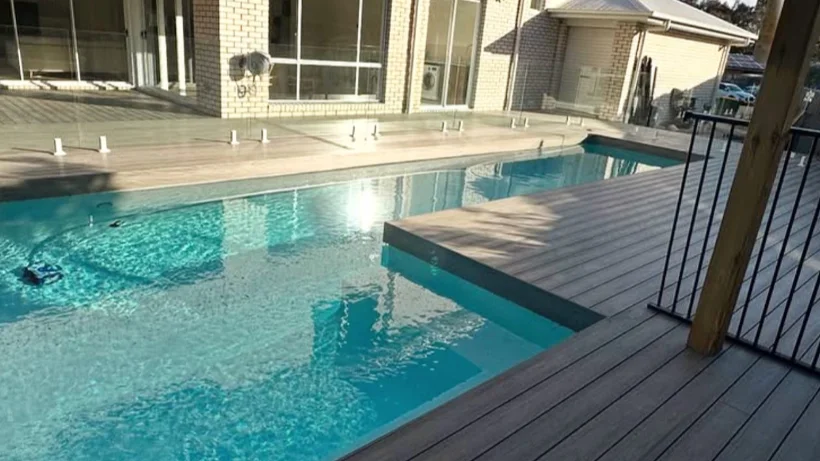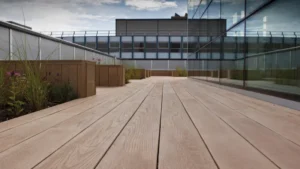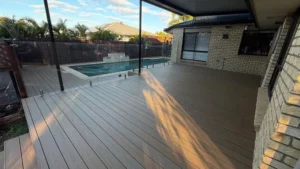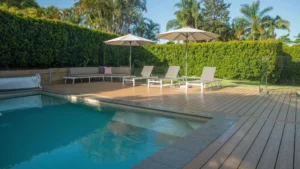
When it comes to installing a spacious deck in your outdoor living area, the array of designs and materials available can be overwhelming. However, thanks to modern, cutting-edge technology, manufacturers have revolutionised outdoor decking options, giving homeowners a sense of control over their daily living and long-term peace of mind.
Although conventional timber decking has been a favourite of many homeowners, other alternatives have made a resounding statement recently. Many customers choose between composite or PVC decking to enhance their home’s functionality and aesthetics.
If you’re faced with the decision between PVC or composite decking and feeling unsure, our team is here to guide you. As a trusted Sydney composite decking stockist with extensive industry experience, we can help you choose the best option for your home, providing you with the reassurance and confidence you need.
This blog will delve deeper into PVC, composite decking, and the critical factors that will help you determine the appropriate fixture for your living space, enabling you to make informed buying decisions and enjoy a high quality of life.
What Is PVC?
Unlike conventional composites, polyvinyl chloride (PVC) decking is manufactured from pure plastic. While manufacturers create the former using recycled plastic and wood, they make the latter using significant amounts of high-grade recycled plastic.
PVC’s sustainability has resonated deeply with many environmentally conscious Australian homeowners, allowing them to contribute to a greener planet. Manufacturers use recycled plastic to create PVC and they can recycle it after at least three decades.
PVC’s 100% synthetic makeup ensures that it won’t mould, deteriorate, or scratch like conventional timber decking. It also doesn’t require frequent maintenance and refinishing, allowing hassle-free enjoyment of your outdoor space. PVC’s low-maintenance features appeal to many busy homeowners who prefer resilient decking without frequent cleanups.
PVC provides homeowners with numerous design options that they can integrate seamlessly into their living spaces. You can choose from various patterns, colour palettes, board widths, and visual elements to spruce up your home. Whether you prefer warm wood tones, rich dark shades, rustic brown, slate grey, high-contrast combinations, or textured surfaces, PVC decking can transform your patio into a vibrant outdoor sanctuary.
Although premium PVC is pricier than composite decking, the former’s numerous advantages provide you with a high return on investment.
What is Composite Decking?
Also known as wood-plastic composite (WPC), composite decking is a versatile option to its conventional timber counterpart. Manufacturers combine recycled wood and plastics to create a fixture that combines the visual appeal of traditional timber with premium, long-term durability.
Similar to PVC, the sustainability of composite decking appeals to many environmentally responsible Australian homeowners. Manufacturers source the latter from 100% recycled materials, providing them with a sustainable alternative to conventional timber.
WPC’s premium resilience resonates with many buyers. Its resistance to rotting, warping, splintering, and insect damage makes it a wise investment for their outdoor living areas.
Premium composite decking can last anywhere from 25 to 50 years. Since it requires minimal upkeep, you only need to wash it several times annually. WPC also doesn’t require refinishing, so you can spend most of your time enjoying your outdoor sanctuary with premium composite decking.
Whether you prefer natural wood tones, modern neutrals, rustic shades, or bolder colours, WPC enhances your home’s visual appeal and increases property value, providing you with a wise, long-term investment.
In terms of pricing, composite decks are more affordable than PVC. For this reason, Australian homeowners seeking a robust, low-maintenance outdoor fixture will get their money’s worth.
PVC Vs Composite Decking: A Tale of the Tape
Choosing the right outdoor deck is critical to enhancing your home’s elegance and functionality. As a trusted Brisbane composite decking stockist who has helped numerous Australian clients install premium outdoor fixtures, we recommend choosing the alternative that aligns with your aesthetic, budget, maintenance, and lifestyle requirements.
When choosing your outdoor deck, it’s crucial to consider your local weather. If you live in an area prone to high-moisture conditions or heavy rains, a water-resistant and durable deck is a must for safety and peace of mind.
The following sections will explore several considerations before choosing PVC or WPC decking, providing you with valuable insight for your living space.
Weight
Composite decking, due to its natural wood fibres, is heavier than PVC. The weight difference can affect installation and long-term stability of the decking. While PVC’s lightweight features facilitate easy assembly, it can also affect the decking’s bounciness.
Therefore, understanding these implications can help you make an informed decision based on your unique requirements and circumstances.
Temperature Resistance
Both PVC and WPC decking will expand and contract slightly with varying temperatures, which can affect the decking’s stability over time. Since both fixtures have plastic, consider placing a heat-resistant grill mat or fireproof pad under your barbecue to prevent surface melting.
Additionally, both decking alternatives can accumulate heat during the hot Aussie summers. Therefore, we recommend choosing lighter colours, such as cedar, teak, ivory, alabaster, driftwood, weathered ash, or light taupe, to cool the surface and ensure comfortable use.
Longevity
Standard composite decking can last up to 25 years. On the other hand, premium WPC can last more than 30 years.
PVC lasts longer than its composite counterpart. The former can last up to 50 years with minimal upkeep, relieving you from the burden of frequent maintenance and allowing you to enjoy an elegant and durable flooring option.
PVC has a longer lifespan than WPC because the absence of organic matter prevents rotting, decaying, and insect damage. The former also has superior water-resistant features than the latter, whose wood fibres can swell slightly with long-term moisture exposure.
PVC Decking Vs Composite Price
PVC has a higher upfront cost than composite decking. Nevertheless, the former’s premium resilience and water resistance can lead to lower maintenance costs over time. Hence, PVC may offer Australian homeowners a higher return on investment, particularly in demanding, high-traffic environments.
Consider composite decking if you’re on a restricted budget seeking a fixture that closely resembles natural timber. On the other hand, PVC is a better option for homeowners prioritising long-term durability and a longer lifespan.
Maintenance
Regardless of your choice, PVC and composite decking require low maintenance over time. Both fixtures require gentle sweeping and scrubbing to eliminate dirt accumulation. However, the upkeep isn’t as tedious and time-consuming as that of conventional timber, freeing up your time for other responsibilities.
We recommend that homeowners residing in extreme-climate environments inspect their composite decks for moisture damage. Their wood fibre components may lead to minor structural issues. Consulting an experienced and reputable contractor can help fix the issue before it escalates further.
Understanding the maintenance requirements of each decking type can help you plan for your fixture’s long-term cost and convenience.
Aesthetics
Both PVC and composite decking provide Australian homeowners with a wide variety of colours and finishes that spruce up their outdoor living areas. However, the latter’s wood fibre component makes it look more natural than PVC, allowing it to mimic woods such as cedar, pine, oak, maple, teak, or tigerwood.
Although PVC resembles natural timber less than WPC, you can enhance your patio’s visual appeal with several eye-catching styles, such as mult-tonal boards, wood-grain embossing, patterned layouts, coastal tones, and mixed material accents.
Conclusion
Choosing between PVC and composite decking can seem daunting, especially with numerous options to choose from. However, there’s no need to worry. Thoughtful, meticulous planning can help you select the best fixture for your outdoor living area.
Considering several crucial factors, including weight, temperature resistance, price, visual appeal, and long-term maintenance, will help you make an informed buying decision. We also recommend considering your unique lifestyle preferences to ensure a high return on investment.
Ezy Decking is Australia’s trusted provider of premium, cost-effective outdoor fixtures that exceed client expectations. Contact us today to schedule an appointment, arrange an on-site inspection, receive a personalised, upfront quotation, and discover high-quality decking solutions that deliver long-term results.
Related Articles

Enhancing Commercial Environments With Composite Decking
Commercial composite decking has revolutionised how Australian businesses and trade activities operate. These premium outdoor fixtures offer clients durability, aesthetics,…

Top 6 Must-Know Facts About Composite Decking
Also known as composite decking, wood-plastic composites (WPC) have gained popularity as a flooring, cladding, or decking material due to…

Deck Replacement vs. Repair: Why Starting Fresh Can Be the Smarter Choice
Composite decking is a game-changer for many Australian homeowners. It’s a low-maintenance, cost-effective fixture that significantly enhances outdoor aesthetics and…





